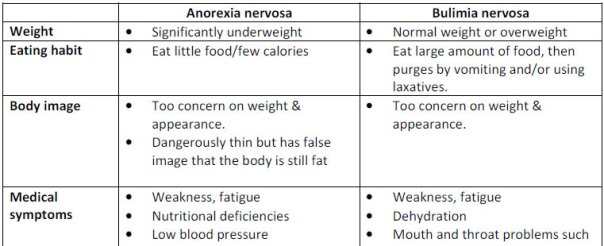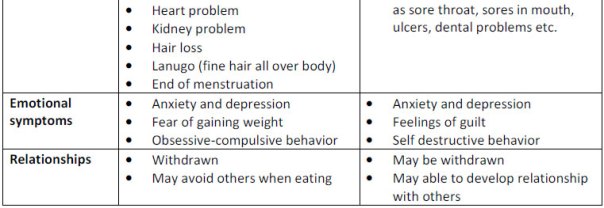Blog Archives
Eating Disorders- Anorexia Nervosa and Bulimia Nervosa
An eating disorder is an illness that causes serious disturbances to your everyday diet, such as eating extremely small amounts of food or severely overeating. Someone with an eating disorder can appear very thin, healthy weighted or above healthy weight. It frequently appears during the teen years or young adulthood but may also develop during childhood or later in life. Eating disorders can become life-threatening if a person does not receive treatment.
Anorexia nervosa is an eating disorder that makes people lose more weight than is considered healthy for their age and height. People with this disorder may have an intense fear of weight gain, even when they are underweight.
Bulimia nervosa is an eating disorder in which a person binges and purges. The person may eat a lot of food at once and then try to get rid of the food by vomiting, using laxatives, or sometimes overexercising.
Anorexia Nervosa vs. Bulimia Nervosa
Prevalence in Malaysia
- In Malaysia, there is no any concrete studies/ systematic research on the prevalence of eating disorders.
- Estimated figure is 1% of the population having anorexia nervosa, 3% having bulimia nervosa.
- For every 10-20 females with eating disorders, there would be one male with similar problem.
- Anorexia nervosa usually occurs in early adolescence, about 14 years old. Bulimia nervosa happens slightly later but still within the young adult population.
Possible Causes and Risk Factors
Being female
Teenage girls and young women are more likely than are teenage boys and young men to have eating disorders.
Age
Eating disorders are more common during the teens and early 20s compared with lesser cases at other life stages.
Family history
Eating disorders more likely to occur in people who have parents or siblings with history of an eating disorder.
Emotional disorders
People with depression, obsessive-compulsive disorder, anxiety disorders, and/or had any transitions that cause emotional distress (joined college, new job or a relationship breakup) may have eating disorders.
Dieting
Eating disorders may occur in people who take up dieting to improve their appearance.
Eating disorders may occur in people whose job/activities favors a slim
body
Work – athletes, actors, television personalities, dancers, models. Sports –ballerinas, gymnasts, runners and wrestlers.
Society
Peer pressure and media influence may fuel the desire to be thin, particularly among young girls. Western cultural environment often cultivates a desire for thinness.
 Treatments and Recovery
Treatments and Recovery
If you suspect yourself or someone else having eating disorder(s), get it treated immediately before
it’s too late. You may see both a medical doctor and a mental health doctor for a diagnosis. They may
do various assessments such as physical exams, laboratory tests (blood and urine) and psychological
(mental health) evaluations to pinpoint a diagnosis.
Medical treatment and drugs
- Psychotherapy is an education which helps to develop healthy habits, problem–solving skills, stress handling skills. It also helps to improve relationships and mood. Family-based therapy may also be considered.
- Nutrition educations in which dietitians can help you achieve a healthy weight and instill normal-eating habits.
- Medication which may helps to control urges to binge or purge or to manage excessive preoccupations with food and diet. Antidepressants and anti-anxiety medications may also help with symptoms of depression or anxiety.
Lifestyle and home remedies
- Practicing proper self-care during and after treatment as per doctor’s advice is crucial to maintain overall health.
- Appropriate vitamin and mineral supplements is essential for a healthier body.
Alternative medicine
Several treatments that help to improve mood, lower stress and reduce anxiety include:
- Chamomile tea
- Acupuncture
- Massage
- Yoga
- Biofeedback
Prevention
For yourself
- Be realistic. The ultra thin models or actresses in popular magazines aren’t healthy bodies.
- Surround yourself with positive influences and be a positive influence yourself.
- Don’t visit websites that advocate or glorify eating disorders.
- Communicate with your friends and family.
- Learn about
For your children, relatives and friends
Encourage healthy-eating habits and avoid dieting around your children.
Family dining habits influence the relationships children develop with food. Eating meals together gives an opportunity to teach children about the pitfalls of dieting, and encourage healthy eating.
Keep an eye on computer use.
There are numerous websites that promote anorexia (commonly called “pro-ana” sites) as a lifestyle. Periodically check the computer’s history page to see what sites your child has visited.
Cultivate and reinforce a healthy body image
Talk to children about their self-image and offer reassurance that body shapes can vary. Encourage children or family members to refrain from joking about others body size.
Reach out if you suspect trouble.
If you notice a family member or friend with low self-esteem, severe dieting, frequent overeating, hoarding of food or dissatisfaction with appearance, consider talking to him or her about these issues. Reaching out with compassion may encourage him or her to recover or seek treatment.
Where to go?
- Malaysia Eating Disorders Therapists provide counselling services by psychiatrists, psychologists, nutritionists and therapists to facilitate rehabilitation.
- Malaysian Mental Health Association Support Group for people who have/had an eating disorder and their caregivers. They meet monthly to share stories and support each other.
Daily Pampering: Organic resort spa opens in Malaysia
 The Chateau Spa and Wellness Resort, the world’s first organic wellness destination spa resort, will open on April 28, 2011 in a 150-million-year-old tropical rainforest in the Berjaya Hills, Malaysia.
The Chateau Spa and Wellness Resort, the world’s first organic wellness destination spa resort, will open on April 28, 2011 in a 150-million-year-old tropical rainforest in the Berjaya Hills, Malaysia.
Modeled after an 18th century medieval ‘Haut Koesnigburg’ castle in Alsace, France, The Chateau has 210 rooms and suites. The Chateau offers three, five, and seven night packages that are specially designed for guests and include accommodation in The Chateau’s spa rooms, daily meals created by their very own dietician, and complete daily fitness and wellness programs.
The five star deluxe spa resort is the first to offer the use of illusive European thermal facilities, which include a herbal infused sauna chamber, salt grotto or mud chamber, and a soap brush/aquaveda heated bed with automatic body scrub facilities. Each guest meets with a member of the spa personnel to create personalized therapies and programs that are designed to meet individual needs and health goals. Use the therapies to work on pampering, beauty, anti-stress, body cleansing, fitness, weight loss, and more.The spa’s unique products are created from The Chateau’s very own ecologically grown gardens. The Chateau also has an array of fitness and wellness activities to experience, including mountain biking, horse riding, trekking, yoga, dance classes, bowling, as well as an 18 hole award winning golf course.
Article excerpted from www.gadling.com






